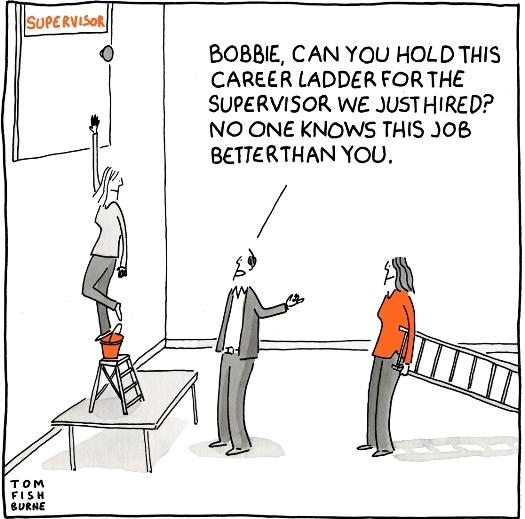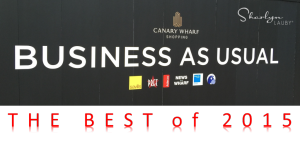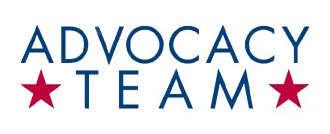Sharlyn J. Lauby's Blog, page 165
December 27, 2015
Thank You and Happy New Year!

I want to take a moment to thank you for being an HR Bartender reader. And for sharing posts on social media. I can’t tell you how much it means to me.
Thank you to all of the people who send me questions and comments. I wish that I could answer them all! But I’m honored that you have confidence in my ability to respond and hope I don’t disappoint.
I’d like to thank the companies that sponsor and advertise on HR Bartender. It’s beyond wonderful to work with you and learn about your products and services.
Mr. Bartender and I hope your holidays are nothing short of fabulous and look forward to the adventures that 2016 will bring. Cheers!
Image courtesy of Sharlyn Lauby
The post Thank You and Happy New Year! appeared first on hr bartender.






December 22, 2015
The Top HR Goal in 2016? Recruiting, Retention and Engagement
This will come as no surprise but employee recruitment, engagement and retention are the hot topics in human resources right now. They are the things keeping the C-Suite up at night. On some level finding and keeping talent has always been important.

But 2016 is going to be different. Employees are comfortable with making job changes. Talent shortages are increasing. Certain skills are hard to find. All of this points to increased pressure on human resources to deliver a talent strategy that will align with business strategy. Here are some activities to consider when developing your talent strategy for 2016:
What Are HR Analysts and Why Should You Pay Attention to Them
HR analysts have been around for a while. But, what do they do? How can HR pros learn from them. An eye-opening view of HR analysts.
Employee Engagement Is At An 8-Year Low
Employee engagement is a key part of retention. Currently, employee engagement is at an 8-year low. Here are three things to consider.
How You Can Become a Simply Irresistible Organization
Employee engagement is critical for retention. Josh Bersin shows us how to increase engagement and become an irresistible organization.
Your Blueprint for Employee Performance Meetings
Performance meetings are something most managers avoid. To help, just follow this easy blueprint for your employee performance meetings.
Prevent Exit Interviews With Stay Interviews
Stay interviews are a great way to understand employee engagement – before they want to leave. For employee retention, try stay interviews.
In my experience, human resources has an incredible opportunity to show their ability to be strategic and relevant by delivering on the talent strategy for the organization. We’re not talking about the process of filling out applications, conducting interviews, and processing new hire paperwork. A talent strategy is about finding individuals that not only fit with the culture but can grow with it.
Image courtesy of Sharlyn Lauby
The post The Top HR Goal in 2016? Recruiting, Retention and Engagement appeared first on hr bartender.






December 20, 2015
Help Employees Do Their Best Every Day
(Editor’s Note: Today’s post is an excerpt from the book, “ It’s All About Bob(bie) – Strategies for Winning With Your Employees ” of which I am one of the contributors. It’s the third book in a thought leadership trilogy aimed at developing and retaining a competitive and engaged workforce published by The Workforce Institute at Kronos . Enjoy the post!)
The story is familiar: Bobbie has been working as a restaurant server in a hotel for several years. She wants to move into a supervisory role, but has been passed over several times by external candidates who don’t have the organizational insight she does. Bobbie and the department win when they invest in building her skills so that she’s ready for the next promotion.
Organizations and employees want the same things and they need each other, although sometimes it’s hard to see it that way. Employees want to work for great companies that they are proud of. And they are very serious about finding them. According to research from Glassdoor.com, applicants are making time to research organizations before they apply to make sure they really want to work for the company before completing an application.
Companies want engaged, productive employees. They want employees who will come to work, give their best and contribute at a high level. However, employee engagement is at a record low according to a study from Quantum Research.
The way organizations can bridge the gap is by creating a learning culture – an organizational culture that encourages employees to grow, learn and improve themselves every day. By doing so, employees feel proud that the company is setting them up for success and investing in their future. Organizations are happy to have employees that represent their brand well and deliver excellent service.
It could be said that every organization’s brand is defined by their customers. And their unique culture is driven by employees. It could be viewed as a continuous loop.
Strong organizational cultures can create positive employee engagement. Engaged employees deliver good customer service. Happy customers help create a valuable brand. Respected brands achieve results that help maintain strong culture. The first step is creating the right culture.
Creating a Learning Culture
The concept of a learning culture was first introduced by Peter Senge, Ph.D., senior lecturer at the MIT Sloan School of Management and author of “The Fifth Discipline: The Art and Price of the Learning Organization”. In the book, Senge outlines five disciplines that must be mastered in order to successfully become a learning organization.
Systems thinking is about understanding how individual things relate as a whole.
Shared vision allows employees to understand and buy-into the organizational vision.
Mental models permit the organization to promote open dialogue.
Team learning focuses on having a knowledge management structure.
Personal mastery emphasizes individual commitment to learning.
As employees we might not have influence in all five of the disciplines that Senge mentions, but the one we do have control over is personal mastery. Whether it’s designing our own personal development plan or helping an employee with theirs, we have the ability to support learning.
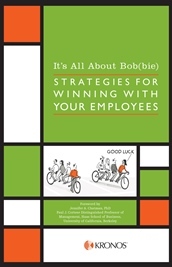 Given the fast pace of today’s business environment, learning has never been more important. And, while we say that everyone needs to be a lifelong learner, it’s time to take that comment one step further. Yes, we must be lifelong learners. But we must also be keenly aware of how we like to learn and what valuable content looks like.
Given the fast pace of today’s business environment, learning has never been more important. And, while we say that everyone needs to be a lifelong learner, it’s time to take that comment one step further. Yes, we must be lifelong learners. But we must also be keenly aware of how we like to learn and what valuable content looks like.
Organizations that embrace learning create cultures that encourage employees to improve their skills and develop themselves for future opportunities. A learning culture provides effective training that employees want to consume. It offers development programs that give employees a sense of belonging so they will stay, ensuring the company’s pipeline of talent is filled with qualified individuals. And, creating a learning culture helps organizations maintain its competitive advantage in this fast-paced business economy.
The post Help Employees Do Their Best Every Day appeared first on hr bartender.






December 18, 2015
Quick Shots for #HR and #Business Pros – Holiday Edition
The gala season is upon us and, for human resources, that means trying to juggle the fun and festivities with legalities and potential risk. I say that a bit tongue and cheek, but it’s true. Do I give a gift to my boss, co-workers and team? If so, what? How much do I spend? And then there are celebrations! Should you have one? If so, is it okay to serve adult beverages?
Here are some terrific articles to help you navigate this special season. Oh, and if you’ve already had your seasonal soiree, keep these thoughts in mind for the spring picnic or any other employee event.
How to Throw a Great Holiday Party – Cheap!
Office Parties Your Employee Want to Attend
I’ve got 99 problems but a holiday party lawsuit ain’t one…
Don’t Let Your Office Party Cheer Steer You Into Court
A Holiday Tale: Guidance from a Jewish guy who wears a chai
5 Etiquette Tips for Your Office Party
The 13 Must-Dos to Include on Your Holiday Checklist
This Holiday Perk Could Last Year-Round
Parties (or summer picnics) were designed to reward and recognize employees for their hard work. All it takes is some smart planning. Cheers to you and yours for a wonderful season!
Image courtesy of Sharlyn Lauby
The post Quick Shots for #HR and #Business Pros – Holiday Edition appeared first on hr bartender.






December 17, 2015
5 Resources For Being a Better Manager in 2016
Being a better manager is hard work. Let’s face it, if it were easy we’d develop an index card with a dozen mantras for success and just hand it out to everyone. Boom – instant success! But, management takes constant self-evaluation and a commitment to regular learning. It means always trying to be a better manager.
If you’re looking for 1-2 things to focus on in 2016, let me offer a handful of suggestions. These are some of the most popular posts on HR Bartender to help you be a better manager.
10 Performance Management Tips for the First Time Supervisor
The first time supervisor can dread their first performance management task. Here are 10 performance management tips for a first time supervisor.
Future Leaders Need Organizational Mindfulness
Organizational development expert Elad Levinson tells us that mindfulness is a necessary trait in leadership. It can be developed at every company level.
The Only 3 Reasons to Hold a Business Meeting
There are only three reasons to hold a business meeting. One of the best skills professionals can develop is the ability to run a good business meeting.
Companies Are Not Prepared for Aging Workers
SHRM reports that companies are not prepared for their aging workers. The risk? Brain drain as company knowledge exits. It takes communication.
Lack of Leadership Has Created the Skills Gap
Has lack of leadership led to the skills gap? We say development is supported from the top down. If the top doesn’t develop new leaders, then what?
Managers are going to have their hands full in 2016. Employee engagement is down. The number of job seekers is increasing. And CEOs say retaining talent is their number one goal. Even seasoned managers will want to keep their skills sharp.
The key to business competitiveness is having the best talent. The last thing companies want to do is hire the best only to have them leave within the first year. That old cliché still rings true, “Employees don’t leave bad companies; they leave bad managers.” Constantly developing managerial skills in the year ahead will positively impact the bottom-line.
Image courtesy of Sharlyn Lauby
The post 5 Resources For Being a Better Manager in 2016 appeared first on hr bartender.






December 15, 2015
HR Advocacy Is a Part of HR Leadership
One of the activities I participated in during this year’s SHRM Volunteer Leaders’ Summit was a visit to Capitol Hill. I’ve visited the Hill before but it had been a long time so I wanted to do it again as part of HR advocacy.
Later in the conference, I was chatting with another attendee about what a great experience it was. She said that she wished she had known because she would have participated. She was afraid to go because she didn’t feel prepared.
Visiting Capitol Hill and HR advocacy should not be a scary experience. Our legislators want to hear from us. So for those who have never visited Capitol Hill or it’s been a long time, let me demystify the process a little.
It’s okay to meet with both Democrats and Republicans.
First things first – meeting with legislators on Capitol Hill isn’t about Democrats and Republicans. At no point will anyone ask for your political persuasion or Voter ID card. These meetings are about business. Specifically, how proposed legislation will impact your organization and your ability to recruit, engage and retain talent in the workplace. That doesn’t change based upon who you’re talking with.
If anything, it can be very enlightening to hear a political view different from your own. In HR, we’re used to hearing different points of view (POV) all the time.
SHRM takes care of the details – all of them!
Kudos to the SHRM Government Affairs team for their attention to detail. When you sign up for a Capitol Hill visit, here’s what happens:
There’s a webinar prior to arriving in Washington to go over what will happen on the day of the Capitol Hill visit.
On the day of the visit, we were given time to meet with the other HR pros from our state. SHRM also provides a debrief of the specific issues we will be discussing with legislators. For our visit, it was the Affordable Care Act (ACA) excise tax and the proposed changes to the Fair Labor Standards Act (FLSA.)
SHRM gives each participant talking points about the legislative issues and a summary of data about your state (population, demographics, etc.) So you really don’t have any homework beyond reading a few pages.
SHRM also provides you with a notebook which includes the same talking points that you can leave at the legislator’s office. So they can review the details at their leisure.
Lastly, all of the logistics are handled by SHRM. We were bussed over to the Capitol (and back), given a couple bucks in lunch money and an umbrella because the weather was unpredictable.
When I tell you SHRM makes sure you’re prepared, I’m not kidding! It was incredibly organized.
It’s not about meeting the Senator or Representative.
I met with my two Senators and one Representative. Well, let me clarify, I met with the staffers of my two Senators and one Representative. There was a vote going on in the House of Representatives about Syrian refugees so my Congresswoman needed to be there. Totally understandable. But from a timing perspective, it was three appointments in a single morning.
I know some people were disappointed that they didn’t get to meet with their elected official. While I wouldn’t have turned down the chance to meet them, the important part was having my POV heard. And I believe that often happens through their staffers. They are responsible for being the subject matter experts (SME) and advising the legislator. No different than what happens in our organizations – the CEO looks to us as the SME in HR.
One voice at a time.
Another comment I heard during the conference was that going to Capitol Hill was a waste of time because “my legislator isn’t going to listen to me.” I completely understand. But personally, I do not expect my legislator to have an epiphany after one 30-minute conversation.
I would challenge people to think about their visit to Capitol Hill this way: SHRM organized over 400 people to visit Congress. We came at the same time to talk about the same issues. To organize such an effort speaks volumes about the role that HR professionals want to play in legislation that impacts business.
Hank Jackson said in his opening remarks, “In Washington, you’re either ‘at the table’ or ‘on the menu.’” The point being that HR needs to be at the table – the advocacy table. Today’s business issues are often human resources issues. If we don’t make our voices heard, we cannot impact change in our organizations. Washington needs our leadership. Get involved.
Oh, and P.S. If you’re planning to attend SHRM’s Employment Law & Legislative Conference in March 2016, plan to visit Capitol Hill. You’ll be glad you did.
SHRM HR Advocacy Logo Used With Permission
The post HR Advocacy Is a Part of HR Leadership appeared first on hr bartender.






December 13, 2015
Are You Virtually Competent
Recently, I ran across an article with that title – Are You Virtually Competent. You can check it out here. It’s a good read about being a virtual instructional designer and facilitator.
But I have to admit, when I saw the title, I thought the article was going to be about being a good virtual participant. Yes, we need to focus on delivering good content in the virtual environment. But in order for virtual learning to take place, we need to have good virtual participants. So I decided to come up with my own list on being virtually competent.
SIDE NOTE: I do have to add, that I’m not a fan of training ground rules. On some level, I’ve always found them to be fairly obvious and the last thing I want to do is insult anyone’s intelligence. But there are days when I’m astonished at the things people do in training. So I guess having a common set of guidelines may still be necessary helpful.
Find a quiet location to participate in training. You don’t want to be disrupted during training and you don’t want to disrupt anyone else. Find a place that will allow you to participate. If you need a telephone, consider a headset for comfort. And if all you have is a cellphone, think about a Plan B in case coverage is spotty.
Remove the distractions. Participants need to figure out how to manage their emails, cellphones, etc. while they are in training. Virtual training programs are not an invitation for multi-tasking. It’s difficult to learn and answer emails at the same time.
Use the proper equipment. If the facilitator says you need a PC or laptop, then chances are a tablet won’t work. If you need a Windows based operating environment, it’s possible OS won’t be compatible. Ask the facilitator to clarify the required equipment– before the session begins.
Make sure the technology works. Check to see that you have the appropriate software for the session. Make sure you have the most current version. If you’ve never used the software before, schedule time to take the tutorial or find out from the facilitator the key features you need to know prior to the session starting.
Participate in chats, polls and discussion. Once the session begins, be an active participant. Your participation tells the instructor that you are comprehending the material. The facilitator can move forward with the session, possibly offer a deep dive into a topic, or add content based upon participant engagement.
According to eLearning Industry, approximately 15 percent of companies are introducing MOOCs into their learning programs and that number is expected to double over the next two years. In addition, 15 percent of corporate training is being delivered in the virtual classroom. The point is, the virtual classroom isn’t going away anytime soon.
Learning how to be a virtually competent participant is just as important as the content being delivered. It’s important not to confuse the flexibility and versatility of virtual learning with the discipline of being an engaged participant.
Image courtesy of Sharlyn Lauby – taken at the HR Technology Conference and Expo
The post Are You Virtually Competent appeared first on hr bartender.






December 11, 2015
Giving Employees the Power of Technology – Friday Distraction
(Editor’s Note: Today’s post is brought to you by our friends at Kronos , the global leader in delivering workforce management solutions in the cloud. The Workforce Institute at Kronos released the third book in its thought leadership trilogy aimed at developing and retaining a competitive and engaged workforce: It’s All About Bob(bie) – Strategies for Winning With Your Employees. Enjoy the post!)
A few weeks ago, I wrote a post about office space design aligning with the work to be done. You can check out the post here. One of the things that I didn’t really touch on in the previous post was technology. And technology is an important part of the way we do business – which drives office space.
At this year’s KronosWorks conference, I had the chance to speak with several companies that were designing their workforce management systems so employees could review schedules and swap shifts using their smartphones. The reason? Giving employees control over their schedule allows the employee to decide when they want to work. Being able to have some sense of control is a contributor to work / life balance, which subsequently increases engagement and retention.
Also, I heard more than a few organizations mention that they were replacing manager laptops with tablets. They wanted managers on the floor coaching employees and taking care of customers, not sitting in a back office working on spreadsheets. It reminded me of this Time Well Spent cartoon about being chained to our desks.
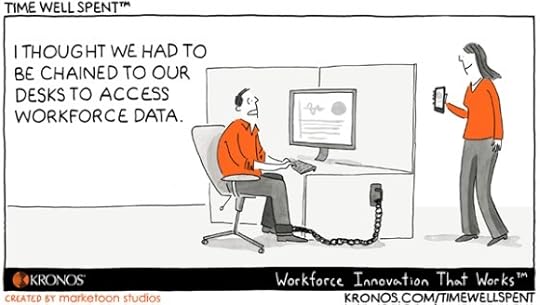
When it comes to designing office space, organizations need to keep technology in mind. People do not want a different experience on their different devices. They want the same experience on their smartphone, tablet, laptop and even desktop. That means making a conscious effort to integrate technology with office design. That gives employees and managers the power they need to do their best work for the company.
The post Giving Employees the Power of Technology – Friday Distraction appeared first on hr bartender.






December 10, 2015
Handling a Negative Sick Pay Balance – Ask #HR Bartender
I hate to say it but sometimes doing someone a favor can create problems. Today’s reader note about sick pay is an example:
I have a salaried employee that has accrued 10 hours vacation and -8 hours sick leave. Since he’s taken a lot of sick leave, I thought I would do him a favor and credit him those sick leave hours as
I figured he would not be leaving anytime soon. My mistake – he’s resigned.
My question is can I deduct the sick leave hours from his final paycheck even though he is a salary employee. Our company is located in California.
Since we don’t know any of the company’s policies regarding sick leave or sick pay, it’s not possible to say, “Yes, you can…” or “No, you can’t…” but there are some details to consider. So I asked one of my favorite labor attorneys to assist.
Eric B. Meyer is a partner in the Labor & Employment Practice Group at the Philadelphia-based Dilworth Paxson LLP. He also serves as Chair of the firm’s #SocialMedia Practice Group, and publishes the blog The Employer Handbook, which was recognized as a top labor and employment law blog by the American Bar Association (ABA) Journal. He’s helped us before with reader questions – this one is a favorite of mine.
I also want to point out that while today’s question comes from a California reader, Eric is not licensed to practice law in California. Therefore, please remember that Eric’s comments should not be construed as legal advice (for California or otherwise) or as pertaining to specific situations, such as the one described above. Nothing he says here will create an attorney-client relationship. Eric’s doing this for free; he gets paid to be a lawyer. Now that we’ve gotten that out of the way…
Eric, we both agree there are lots of unknown issues here. So let’s talk about the things we can address. How does sick time work for salaried (exempt) employees?
 [Meyer] The laws on sick time and other paid time off for exempt employees can vary from state to state and city to city. For example, some cities, like Philadelphia, PA, require that employers provide a certain amount of sick leave to all employees (exempt and non-exempt) based on the number of hours of work that they have accrued. Absent a relevant state or local law, employers can establish sick leave rules by contract or handbook. That’s important because, under the Fair Labor Standards Act (FLSA) regulations, an employer may deduct pay from an exempt employee’s salary ‘for absences of one or more full days occasioned by sickness or disability (including work-related accidents) if the deduction is made in accordance with a bona fide plan, policy or practice of providing compensation for loss of salary occasioned by such sickness or disability.’
[Meyer] The laws on sick time and other paid time off for exempt employees can vary from state to state and city to city. For example, some cities, like Philadelphia, PA, require that employers provide a certain amount of sick leave to all employees (exempt and non-exempt) based on the number of hours of work that they have accrued. Absent a relevant state or local law, employers can establish sick leave rules by contract or handbook. That’s important because, under the Fair Labor Standards Act (FLSA) regulations, an employer may deduct pay from an exempt employee’s salary ‘for absences of one or more full days occasioned by sickness or disability (including work-related accidents) if the deduction is made in accordance with a bona fide plan, policy or practice of providing compensation for loss of salary occasioned by such sickness or disability.’
In my experience, it’s rare for an organization to take any employee’s discretionary time balances – whether that’s sick or vacation – into the negative. What should organizations consider when employees need more paid time than they have available?
[Meyer] If there is a written policy on point, apply that first. Attendance policies should be consistent with past pattern and practice. An alternative is to provide unpaid time off, consistent with policy, pattern, practice.
Out of curiosity, should the employee have any responsibility in this? I’d like to think the employee was aware that they were out of sick pay.
[Meyer] The employee should know the sick leave policy. Apart from that, the onus is on the employer to educate and train the employee on the policy and to apply it correctly.
Last question, from your perspective, do situations like this make the case for paid time off (PTO) easier?
[Meyer] I find it simpler to put all forms of paid time off (e.g., sick, vacation, personal) into one bucket from which employees may draw.
A huge thanks to Eric for sharing his expertise. If you’re not already reading his sage advice, be sure to check out his blog and follow him on Twitter.
I’ve always said that I never wanted to be the human resources director that banned Girl Scout cookies. Sometimes being in HR or payroll is a tough job. The organization creates rules and policies for a reason – to bring consistency to the workplace. It’s our job to make sure that consistency is maintained. Or we can explore changing the sick pay policy…but that’s another blog post.
Image courtesy of Sharlyn Lauby
The post Handling a Negative Sick Pay Balance – Ask #HR Bartender appeared first on hr bartender.






December 8, 2015
7 Things New Managers Should Do In the First 6 Months
When you’re a new manager, it’s hard to know exactly the right things to do. New managers want to make a good impression but they have things that must get done. That’s the dilemma this reader is facing:
Hello. i just got a new job as HR manager and this is my first experience in managerial role. i do have experience in human resources and I’m a certified professional (SHRM-SCP.) The HR department is small – just an administrator and myself.
The company is a manufacturing facility with 300 employees. I have immediately noticed that staff morale is an issue. I’m trying to figure out how to plan my efforts for the first six months. i believe with your wealth of experience, you can give me useful advice and recommendations.
First of all, congratulations on your new role! My first HR manager role was in a small department as well. It can be incredibly overwhelming but, at the same time, a fantastic learning opportunity. Here are a few things to consider during your first six months:
Get to know your boss. THIS is the number one thing on your list. Yes, this person hired you. And they want you to be successful. But do not blindside them. You want to understand 1) what you can do and not tell your boss, 2) what you can do and tell your boss later and 3) what you need to tell your boss immediately.
Find out what your peers expect. You have a great sense of the competencies for your profession. Now, it’s time to confirm those with the individuals that you have to work with every day. Trust me, they will very much appreciate being asked the question, “What do you expect from me and the department?”
Build a relationship with your team. Find out the background and experience of your team members. What are their goals? Let them find out the same about you. Also make sure they know what is expected of them from other departments. Get their take on the responses. Do they agree or disagree?
Learn your company and industry. Even if you were promoted from within, it’s possible there are things you need to learn. Company financials, budgets, market share, customer satisfaction, etc. New managers are expected to have knowledge of the operation – regardless of your department.
Touch everything in your office. What I mean here is open the drawers, look at the files, etc. Understand how the office works. That might shed some light on the best solutions to implement. You need to understand logistics to make good decisions.
Resist the temptation to create change. It’s very easy to say, “This is what we did at ABC company.” Or “I prefer to do XX over YY.” Always ask yourself if something really needs to be changed – at least initially. You’re building credibility and a reputation. Employees want to know that you’re taking the time to evaluate all options before creating change.
Make a list, then prioritize. You’re going to see a lot of things that you want to change or that don’t make sense. Unless they are things that are hazardous, unethical or illegal, it might make sense just to make a mental note of them. Then do your homework – ask employees why they exist. Find out the history. Then figure out what to tackle first.
Even when you’ve been hired to make change happen in the organization, you have to take time to build relationships with the team and understand the organization. Every company’s interpretation of “change agent” is different.
What advice would you give to new managers during their first six months on the job? Share your suggestions!
Image courtesy of Sharlyn Lauby
The post 7 Things New Managers Should Do In the First 6 Months appeared first on hr bartender.






Sharlyn J. Lauby's Blog
- Sharlyn J. Lauby's profile
- 10 followers


